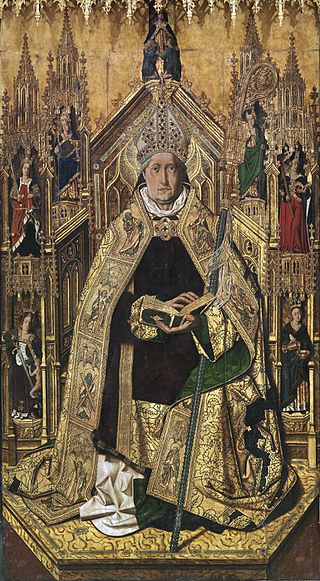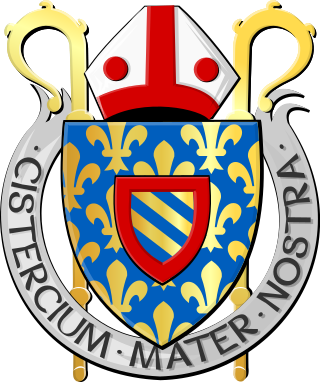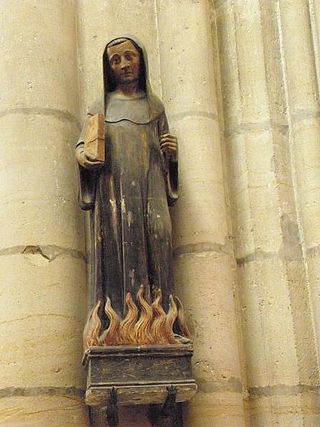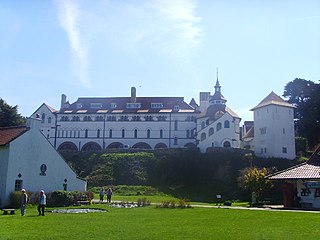
Abbot is an ecclesiastical title given to the head of an independent monastery for men in various Western Christian traditions. The name is derived from abba, the Syriac form of the Hebrew ab, and means "father". The female equivalent is abbess.

An abbey is a type of monastery used by members of a religious order under the governance of an abbot or abbess. Abbeys provide a complex of buildings and land for religious activities, work, and housing of Christian monks and nuns.

The Benedictines, officially the Order of Saint Benedict, are a mainly contemplative monastic order of the Catholic Church for men and for women who follow the Rule of Saint Benedict. Initiated in 529 they are the oldest of all the religious orders in the Latin Church. The male religious are also sometimes called the Black Monks, especially in English speaking countries, after the colour of their habits. Not all Benedictines wear black however, with some like the Olivetans wearing white. They were founded by Benedict of Nursia, a 6th-century Italian monk who laid the foundations of Benedictine monasticism through the formulation of his Rule. Benedict's sister, Scholastica, possibly his twin, also became a religious from an early age, but chose to live as a hermit. They retained a close relationship until her death.

A monastery is a building or complex of buildings comprising the domestic quarters and workplaces of monastics, monks or nuns, whether living in communities or alone (hermits). A monastery generally includes a place reserved for prayer which may be a chapel, church, or temple, and may also serve as an oratory, or in the case of communities anything from a single building housing only one senior and two or three junior monks or nuns, to vast complexes and estates housing tens or hundreds. A monastery complex typically comprises a number of buildings which include a church, dormitory, cloister, refectory, library, balneary and infirmary, and outlying granges. Depending on the location, the monastic order and the occupation of its inhabitants, the complex may also include a wide range of buildings that facilitate self-sufficiency and service to the community. These may include a hospice, a school, and a range of agricultural and manufacturing buildings such as a barn, a forge, or a brewery.

The Cistercians, officially the Order of Cistercians, are a Catholic religious order of monks and nuns that branched off from the Benedictines and follow the Rule of Saint Benedict, as well as the contributions of the highly-influential Bernard of Clairvaux, known as the Latin Rule. They are also known as Bernardines, after Saint Bernard himself, or as White Monks, in reference to the colour of the "cuculla" or cowl worn by the Cistercians over their habits, as opposed to the black cowl worn by Benedictines.

The dissolution of the monasteries, occasionally referred to as the suppression of the monasteries, was the set of administrative and legal processes between 1536 and 1541, by which Henry VIII disbanded Catholic monasteries, priories, convents, and friaries in England, Wales, and Ireland; seized their wealth; disposed of their assets; and provided for their former personnel and functions.

A convent is a community of monks, nuns, friars or religious sisters. Alternatively, convent means the building used by the community. The word is particularly used in the Catholic Church, Lutheran churches, and the Anglican Communion.

Cluny Abbey is a former Benedictine monastery in Cluny, Saône-et-Loire, France. It was dedicated to Saints Peter and Paul.
The Cluniac Reforms were a series of changes within medieval monasticism in the Western Church focused on restoring the traditional monastic life, encouraging art, and caring for the poor. The movement began within the Benedictine order at Cluny Abbey, founded in 910 by William I, Duke of Aquitaine (875–918). The reforms were largely carried out by Saint Odo and spread throughout France, into England, and through much of Italy, northern Portugal and Spain.

The English Benedictine Congregation (EBC) is a congregation of autonomous abbatial and prioral monastic communities of Catholic Benedictine monks, nuns, and lay oblates. It is technically the oldest of the nineteen congregations affiliated to the Benedictine Confederation.
Prior is an ecclesiastical title for a superior in some religious orders. The word is derived from the Latin for "earlier" or "first". Its earlier generic usage referred to any monastic superior. In abbeys, a prior would be lower in rank than the abbey's abbot or abbess.

Odilo of Cluny was the 5th Benedictine Abbot of Cluny, succeeding Mayeul and holding the post for around 54 years. During his tenure Cluny became the most important monastery in western Europe. Odilo actively worked to reform the monastic practices not only at Cluny, but at other Benedictine houses. He also promoted the Truce of God whereby military hostilities were temporarily suspended at certain times for ostensibly religious reasons. Odilo encouraged the formal practice of personal consecration to Mary. He established All Souls' Day in Cluny and its monasteries as the annual commemoration to pray for all the faithful departed. The practice was soon adopted throughout the whole Western church. He was lifelong friends with William of Dijon, another Cluniac abbot and reformer.

In the Middle Ages, from the 11th century, the Cluniac order established a number of religious houses in England, Wales, and Scotland.

Caldey Abbey is an abbey of the Trappists situated on Caldey Island off the coast of Pembrokeshire, Wales, south of Tenby.
Monasteries in Spain have a rich artistic and cultural tradition, and serve as testament to Spain's religious history and political-military history, from the Visigothic Period to the Middle Ages. The monasteries played an important role in the recruitment conducted by Christian aristocracy during and after the progress of the Reconquista, with the consequent decline in the Muslim south of the peninsula.
A dependency, among monastic orders, denotes the relation of a monastic community with a newer community which it has founded elsewhere. The relationship is that of the founding abbey or conventual priory, termed the motherhouse, with a monastery composed of the monks or nuns of the new community, which is called the daughter house. In that situation, the abbot or abbess remains the ultimate authority for the affairs of the dependent priory, which is considered an extension of the founding house. This relationship will end at such time as the new community becomes fully autonomous in its own right.












